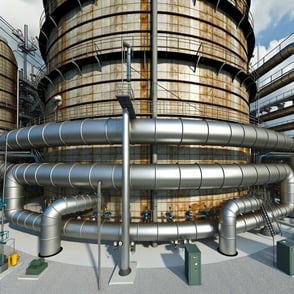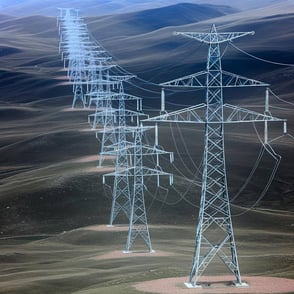Flywheel Energy Storage
Flywheel energy storage stores kinetic energy by spinning a rotor at high speeds, offering rapid energy release, enhancing grid stability, supporting renewables, and reducing energy costs.
What is Flywheel Energy Storage?
Flywheel energy storage is a form of mechanical energy storage that works by spinning a rotor (flywheel) at very high speeds. This stored energy can be quickly converted back to electricity when needed, providing a reliable and efficient way to manage power supply and demand. Flywheel energy storage systems are known for their rapid response times, high power density, and long cycle life, making them suitable for applications requiring quick bursts of power and frequent cycling.
The concept of flywheel energy storage dates back to ancient times. In antiquity, potter’s wheels operated using a heavy wooden disc regulated by foot. This basic principle was later applied to 19th-century steam engines and early 20th-century streetcars, which used heavy flywheels to store and release energy between stations. Today, advances in materials and technology have significantly improved the efficiency and capacity of flywheel systems, making them a viable solution for modern energy storage challenges.
How Flywheel Energy Storage Works
Flywheel energy storage systems consist of a rotor (flywheel), a motor/generator, magnetic bearings, and a containment system. The rotor, typically made from advanced materials like carbon fiber, is enclosed in a vacuum chamber to minimize air friction. When charging, electrical energy from the grid or a power source is used to accelerate the flywheel to very high speeds. This is done by the motor/generator acting as a motor, converting electrical energy into kinetic energy and storing it in the spinning flywheel. When energy is needed, the flywheel's rotational energy is converted back into electrical energy. The motor/generator now acts as a generator, slowing down the flywheel and converting its kinetic energy into electrical energy, which is then fed back into the grid or used by connected loads. To minimize friction and energy loss, the flywheel is often supported by magnetic bearings, which allow it to spin with minimal resistance. This increases the efficiency and lifespan of the system. The flywheel and its components are housed within a robust containment system designed to handle the high rotational speeds and ensure safety. Flywheels can achieve very high rotational speeds, often exceeding tens of thousands of revolutions per minute (RPM). The energy stored in a flywheel is proportional to the square of its rotational speed, meaning higher speeds result in significantly more stored energy.
.png?width=714&height=583&name=FlyWheel.drawio%20(1).png)
There are two types of flywheel storage systems. Low-speed flywheels typically operate at lower rotational speeds and use conventional bearings. They are often used in applications where robustness and durability are prioritized over maximum energy storage capacity. Converseley, high-speed flywheels operate at very high rotational speeds and use advanced magnetic bearings to minimize friction, and are designed for maximum energy storage used in applications requiring quick response times and high power output.
The Impact of Flywheel Energy Storage on the Energy Sector
Flywheel energy storage offers numerous advantages, making it a vital technology in the energy sector. One of its primary benefits is efficiency; flywheels can recover up to 80% of the stored energy, ensuring minimal losses during the conversion process. Their rapid response capability makes them ideal for delivering ancillary services requiring immediate power delivery, such as stabilizing power grids and providing backup power. The long operational life and low maintenance requirements of flywheels further enhance their economic viability, making them a cost-effective solution for energy storage.
Flywheels play a crucial role in enhancing grid stability and reliability. They can respond almost instantaneously to fluctuations in electricity supply and demand, providing services such as frequency regulation and voltage support. This rapid response is essential for maintaining grid stability during peak demand periods or unexpected disruptions. In cities like New York, flywheel systems help stabilize the grid by offsetting drops in voltage and ensuring a steady supply of electricity.
The integration of renewable energy sources is another application of flywheel energy storage. Flywheels can absorb excess energy generated from wind and solar power during periods of high output and release it when generation drops or demand increases. This capability helps smooth out the variability of renewable energy and ensures a consistent power supply. By supporting the integration of renewable energy, flywheels contribute to a cleaner and more sustainable energy future.
In public transportation, flywheels are used to store and recover energy from braking trains, as seen in subway systems in Rennes, France. This application saves significant amounts of electricity annually and improves the efficiency of public transport systems. In the automotive sector, high-speed flywheels provide extra power during acceleration, particularly in Formula One cars, demonstrating their versatility in various applications.
By reducing the need for expensive peaking power plants and enhancing the efficiency of energy use, flywheels can lower overall energy costs. Additionally, the environmental impact of flywheel systems is minimal compared to chemical batteries, as they do not involve hazardous materials or generate waste. This makes flywheels a clean and sustainable energy storage solution, contributing to lower greenhouse gas emissions and a smaller carbon footprint.
Conclusion
Flywheel energy storage is a versatile and efficient technology that plays a crucial role in modern energy systems. Its ability to rapidly store and release energy allows it to enhance grid stability, support renewable energy integration, and provide economic and environmental benefits. With a history rooted in ancient technologies and modern advancements pushing its capabilities further, flywheel energy storage systems are poised to be an essential component in the transition to a sustainable and resilient energy future.
Glossary
- Flywheel Energy Storage (FESS): A technology that stores electrical energy as kinetic energy in a rotating flywheel and converts it back to electricity when needed.
- Rotor (Flywheel): The spinning component of a flywheel energy storage system that stores kinetic energy.
- Motor/Generator: A device that functions as both a motor to convert electrical energy into kinetic energy and as a generator to convert kinetic energy back into electrical energy.
- Magnetic Bearings: Bearings that use magnetic fields to support the flywheel, reducing friction and increasing efficiency.
- Containment System: The structure that houses the flywheel and its components, designed to ensure safety at high rotational speeds.
- RPM (Revolutions Per Minute): A measure of the speed at which the flywheel rotates.
- Grid Stability: The ability of the electricity grid to maintain a consistent and reliable supply of electricity despite fluctuations in demand and supply.
- Renewable Energy: Energy generated from natural resources that are replenished continuously, such as wind, solar, and hydropower.
- Frequency Regulation: The process of maintaining the stability of the electrical grid's frequency by balancing supply and demand.
- Voltage Support: The provision of reactive power to maintain voltage levels within the required range for grid stability.
.png?width=200&height=80&name=etpa-logo-color%20(1).png)































.png)
.png)
-1.png?width=250&height=100&name=etpa-logo-color%20(1)-1.png)